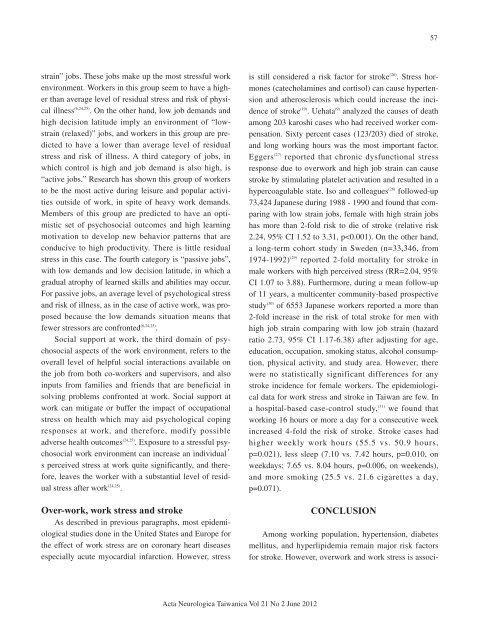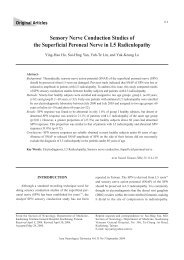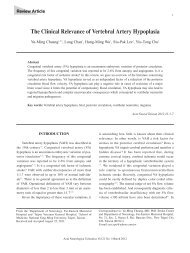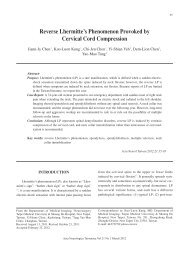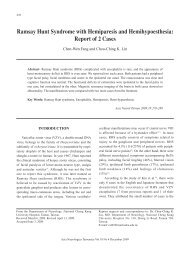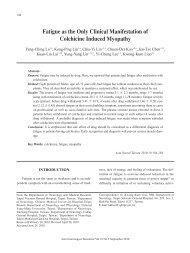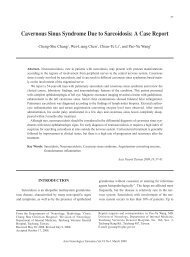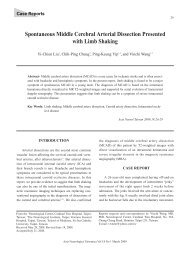Overwork, Stroke, and Karoshi-death from Overwork - Ant
Overwork, Stroke, and Karoshi-death from Overwork - Ant
Overwork, Stroke, and Karoshi-death from Overwork - Ant
You also want an ePaper? Increase the reach of your titles
YUMPU automatically turns print PDFs into web optimized ePapers that Google loves.
strain” jobs. These jobs make up the most stressful work<br />
environment. Workers in this group seem to have a higher<br />
than average level of residual stress <strong>and</strong> risk of physical<br />
illness (6,24,25) . On the other h<strong>and</strong>, low job dem<strong>and</strong>s <strong>and</strong><br />
high decision latitude imply an environment of “lowstrain<br />
(relaxed)” jobs, <strong>and</strong> workers in this group are predicted<br />
to have a lower than average level of residual<br />
stress <strong>and</strong> risk of illness. A third category of jobs, in<br />
which control is high <strong>and</strong> job dem<strong>and</strong> is also high, is<br />
“active jobs.” Research has shown this group of workers<br />
to be the most active during leisure <strong>and</strong> popular activities<br />
outside of work, in spite of heavy work dem<strong>and</strong>s.<br />
Members of this group are predicted to have an optimistic<br />
set of psychosocial outcomes <strong>and</strong> high learning<br />
motivation to develop new behavior patterns that are<br />
conducive to high productivity. There is little residual<br />
stress in this case. The fourth category is “passive jobs”,<br />
with low dem<strong>and</strong>s <strong>and</strong> low decision latitude, in which a<br />
gradual atrophy of learned skills <strong>and</strong> abilities may occur.<br />
For passive jobs, an average level of psychological stress<br />
<strong>and</strong> risk of illness, as in the case of active work, was proposed<br />
because the low dem<strong>and</strong>s situation means that<br />
fewer stressors are confronted (6,24,25) .<br />
Social support at work, the third domain of psychosocial<br />
aspects of the work environment, refers to the<br />
overall level of helpful social interactions available on<br />
the job <strong>from</strong> both co-workers <strong>and</strong> supervisors, <strong>and</strong> also<br />
inputs <strong>from</strong> families <strong>and</strong> friends that are beneficial in<br />
solving problems confronted at work. Social support at<br />
work can mitigate or buffer the impact of occupational<br />
stress on health which may aid psychological coping<br />
responses at work, <strong>and</strong> therefore, modify possible<br />
adverse health outcomes (24,25) . Exposure to a stressful psychosocial<br />
work environment can increase an individual<br />
s perceived stress at work quite significantly, <strong>and</strong> therefore,<br />
leaves the worker with a substantial level of residual<br />
stress after work (24,25) .<br />
Over-work, work stress <strong>and</strong> stroke<br />
As described in previous paragraphs, most epidemiological<br />
studies done in the United States <strong>and</strong> Europe for<br />
the effect of work stress are on coronary heart diseases<br />
especially acute myocardial infarction. However, stress<br />
Acta Neurologica Taiwanica Vol 21 No 2 June 2012<br />
57<br />
is still considered a risk factor for stroke (26) . Stress hormones<br />
(catecholamines <strong>and</strong> cortisol) can cause hypertension<br />
<strong>and</strong> atherosclerosis which could increase the incidence<br />
of stroke (19) . Uehata (9) analyzed the causes of <strong>death</strong><br />
among 203 karoshi cases who had received worker compensation.<br />
Sixty percent cases (123/203) died of stroke,<br />
<strong>and</strong> long working hours was the most important factor.<br />
Eggers (27) reported that chronic dysfunctional stress<br />
response due to overwork <strong>and</strong> high job strain can cause<br />
stroke by stimulating platelet activation <strong>and</strong> resulted in a<br />
hypercoagulable state. Iso <strong>and</strong> colleagues (28) followed-up<br />
73,424 Japanese during 1988 - 1990 <strong>and</strong> found that comparing<br />
with low strain jobs, female with high strain jobs<br />
has more than 2-fold risk to die of stroke (relative risk<br />
2.24, 95% CI 1.52 to 3.31, p


